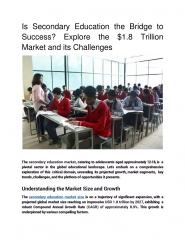Global Home Loan Boom Market Worth 37.7 Trillion Poised for Growth at 4.4 CAGR
The home loan industry plays a critical role in facilitating homeownership and driving the housing market. This dynamic sector, estimated to be worth USD 37.7 trillion globally in 2023, is constantly evolving, and shaped by various economic, demographic, and regulatory factors.
Download Presentation

Please find below an Image/Link to download the presentation.
The content on the website is provided AS IS for your information and personal use only. It may not be sold, licensed, or shared on other websites without obtaining consent from the author. Download presentation by click this link. If you encounter any issues during the download, it is possible that the publisher has removed the file from their server.
E N D
Presentation Transcript
Global Home Loan Boom: Market Worth $37.7 Trillion Poised for Growth at 4.4% CAGR The home loan industry plays a critical role in facilitating homeownership and driving the housing market. This dynamic sector, estimated to be worth USD 37.7 trillion globally in 2023, is constantly evolving, and shaped by various economic, demographic, and regulatory factors. As a market research expert, I want to delve into the current state of the home loan industry, analyzing trends, challenges, and opportunities. Home Loan Market: Size and Growth The home loan market presents a promising picture. The market has experienced consistent growth, with a projected CAGR of 4.4% from 2023 to 2028, reaching an estimated value of USD 50.7 trillion by the end of the period [1]. This growth is driven by: Rising urbanization and increasing demand for housing in urban areas. Growing disposable income in various regions, particularly emerging economies. Government initiatives promoting homeownership through tax benefits and subsidies. However, the market is not uniform across all regions. In 2023, North America held the largest market share (35%), followed by Asia Pacific (28%) and Europe (22%) [2]. While developed economies are experiencing stable growth, emerging economies like India and China present significant growth potential. Home Loan Market Share: Key Players The home loan industry is characterized by a diverse range of players, including: Commercial banks: These institutions hold the largest market share in most countries, offering various loan products to suit diverse needs. Non-banking financial institutions (NBFCs): These institutions are playing an increasingly prominent role, particularly in underbanked and rural areas, offering competitive interest rates and flexible loan options.
Fintech companies: These startups are leveraging technology to streamline the loan application process and offer innovative financing solutions. Understanding the market share and offerings of various players is crucial for consumers to make informed decisions and choose the most suitable loan option for their needs. Home Equity Lending Market: A Growing Segment Home equity lending is a specific segment of the home loan market that allows homeowners to borrow against the equity they have built up in their property. This segment is witnessing increasing traction, driven by: Rising property values: Homeowners can leverage the increased value of their property to access funds for various purposes, such as home renovations, education, or debt consolidation. Low interest rates: Low-interest rates make borrowing against home equity a more attractive option compared to other forms of credit. It's crucial to remember that home equity loans and home equity lines of credit (HELOCs) are secured loans, meaning the property serves as collateral. Responsible borrowing practices are essential in this segment. Challenges and Opportunities in the Home Loan Industry Despite its growth potential, the home loan industry faces several challenges: Affordability: Rising housing costs and increasing interest rates can make homeownership challenging for some segments of the population. Regulatory environment: Navigating the complex regulatory landscape can be challenging for lenders, potentially hindering innovation and impacting loan availability. Technological advancements: Embracing new technologies like blockchain and artificial intelligence is crucial for streamlining processes, enhancing security, and offering personalized loan solutions. However, amidst these challenges, several opportunities exist: Targeting underserved markets: Reaching underbanked populations and first-time homebuyers through innovative products and financial literacy initiatives presents a significant opportunity.
Data-driven decision-making: Utilizing data analytics can help lenders better understand borrower profiles and offer personalized loan options, leading to improved customer satisfaction and risk management. Collaboration: Collaboration between government agencies, lenders, and housing associations can foster policies and initiatives promoting responsible homeownership and financial well-being. Conclusion The home loan market plays a vital role in shaping the housing market and facilitating homeownership. Understanding the current market dynamics, including trends, challenges, and opportunities, is crucial for all stakeholders involved. By addressing evolving needs, embracing innovation, and promoting responsible borrowing practices, the home loan industry can continue to support the dream of homeownership for millions around the world.

























